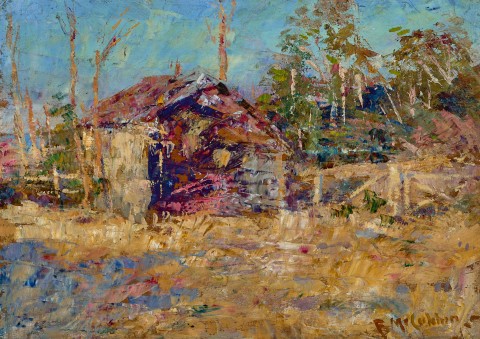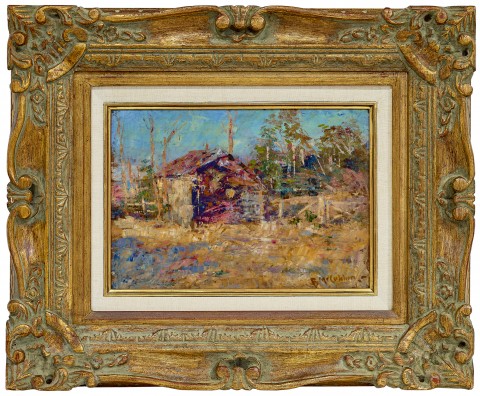(1855 - 1917)
Frederick Mccubbin
Bush farm, c.1910
oil on wood panel
Joseph Brown Gallery, Melbourne
Private collection, Queensland, acquired from the above in 1977
Winter Exhibition 1977, Recent Acquisitions, Joseph Brown Gallery, Melbourne, 4 – 14 July 1977, cat. 37 (illus. in exhibition catalogue)
Frederick McCubbin only went overseas once in his life, departing May 1907 at the age of fifty-two for a relatively brief journey of four-and-a-half months. Arriving in England in early July, what he encountered in the galleries of London and then France was transformative, initiating a radical transition in his art upon his return. He was particularly inspired by close inspection of paintings by Constable and Monet, but his true hero was Turner, writing to his wife Annie that his were ‘such dreams of colour… they glow with a tender brilliancy that radiates.’1 McCubbin was already considered a master painter of the Australian bush, as seen to full effect in such masterworks as Lost, 1886 (National Gallery of Victoria); Down on his luck, 1889 (Art Gallery of Western Australia); Bush burial, 1890 (Geelong Art Gallery); and The pioneer, 1904 (National Gallery of Victoria). However, this earlier palette was earthier, full of grey-greens and tinged with hints of melancholy. After Europe, light itself became the subject and McCubbin ‘no longer found it necessary to tell narratives, or to people the landscape. Instead, he painted images radiant with colour and energy.’2
Bush farm, c.1910, is one such work filled with painterly optimism and vibrancy. The subject is most likely a shed located on one of the neighbouring properties to the McCubbin family’s two storey cottage ‘Fontainebleau’, nestled in the Macedon Ranges on the traditional lands of the Dja Dja Wurrung, Taungurung and Wurundjeri Woi Wurrung people, which possessed a clear view to Hanging Rock (see Landscape, Mt Macedon, Deutscher and Hackett, Sydney, 7 May 2025, lot. 69). McCubbin adored Fontainebleau and spent many happy weeks there each year, often joined by students he taught at the National Gallery School who would visit during their summer vacation, pitching their tents in the bush close to the house (his wife Annie was renowned for her generous lunches). His youngest daughter Kathleen recalled her father ‘going into the bush with his battered old felt hat and his painting coat which was smeared with paint. He used to go and find a secluded spot and put down his camping stool and he would paint his subjects right there in the bush on the spot… He didn’t need to wander far because there were so many paintable subjects right there close to the cottage.’3 National Gallery of Australia curator Anne Gray notes that intimate works such as Bush farm were most likely painted for private viewing rather than exhibition, and were ‘much admired by his artist friends, family, and some discriminating collectors.’4
Bush farm is richly coloured in violet, pink, blue and sage green, and McCubbin has applied the paint vigorously with a palette knife, including the trunks of the trees to the right, though those to the left are constructed from side-dashes marked in with a brush. In size and technique, this lot is near identical to Ti tree glade, 1910 (National Gallery of Victoria) though that painting is a close-up view of dense bush, lacking the kaleidoscopic colours that so distinguish Bush farm.
1. Fred McCubbin, Letter to Annie McCubbin, 19 July 1907, cited in Gray, A. (ed.), McCubbin: last impressions 1907 – 17, National Gallery of Australia, Canberra, 2009, pp. 17, 259 (footnote 5)
2. Gray, ibid., p. 45
3. Kathleen Mangan, cited in McKenzie, A., Frederick McCubbin 1855 – 1917: ‘The Proff’ and his art, Mannagum Press, Melbourne, 1990, p. 144
4. Gray, op cit., p. 18
ANDREW GAYNOR


